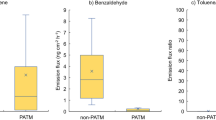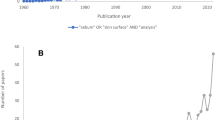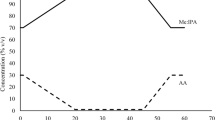Abstract
Volatile organic compounds (VOCs) and semi-VOCs detected on the human skin surface are of great interest to researchers in the fields of metabolomics, diagnostics, and skin microbiota and in the study of anthropophilic vector mosquitoes. Mosquitoes use chemical cues to find their host, and humans can be ranked for attractiveness to mosquitoes based on their skin chemical profile. Additionally, mosquitoes show a preference to bite certain regions on the human host. In this study, the chemical differences in the skin surface profiles of 20 human volunteers were compared based on inter-human attractiveness to mosquitoes, as well as inter- and intra-human mosquito biting site preference. A passive, non-invasive approach was followed to sample the wrist and ankle skin surface region. An in-house developed polydimethylsiloxane (PDMS) passive sampler was used to concentrate skin VOCs and semi-VOCs prior to thermal desorption directly in the GC inlet with comprehensive gas chromatography coupled to time-of-flight mass spectrometry (GC×GC-TOFMS). Compounds from a broad range of chemical classes were detected and identified as contributing to the differences in the surface skin chemical profiles. 5-Ethyl-1,2,3,4-tetrahydronaphthalene, 1,1′-oxybisoctane, 2-(dodecyloxy)ethanol, α,α-dimethylbenzene methanol, methyl salicylate, 2,6,10,14-tetramethylhexadecane, 1,2-benzenedicarboxylic acid, bis(2-methylpropyl) ester, 4-methylbenzaldehyde, 2,6-diisopropylnaphthalene, n-hexadecanoic acid, and γ-oxobenzenebutanoic acid ethyl ester were closely associated with individuals who perceived themselves as attractive for mosquitoes. Additionally, biological lead compounds as potential attractants or repellants in vector control strategies were tentatively identified. Results augment current knowledge on human skin chemical profiles and show the potential of using a non-invasive sampling approach to investigate anthropophilic mosquito-host interactions.

Graphical abstract





Similar content being viewed by others
References
De Lacy CB, Amann A, Al-Kateb H, Flynn C, Filipiak W, Khalid T, et al. A review of the volatiles from the healthy human body. J Breath Res. 2014;8(1):014001.
Jiang R, Cudjoe E, Bojko B, Abaffy T, Pawliszyn J. A non-invasive method for in vivo skin volatile compounds sampling. Anal Chim Acta. 2013;804:111–9.
Filipiak W, Mochalski P, Filipiak A, Ager C, Cumeras R, E Davis C, et al. A compendium of volatile organic compounds (VOCs) released by human cell lines. Curr Med Chem. 2016;23(20):2112–31.
Belinato JR, Silva E, de Souza DS, Março PH, Valderrama P, do Prado RM, et al. Rapid discrimination of fungal strains isolated from human skin based on microbial volatile organic profiles. J Chromatogr B. 2019;1110:9–14.
Zwiebel L, Takken W. Olfactory regulation of mosquito–host interactions. Insect Biochem Mol Biol. 2004;34(7):645–52.
Verhulst NO, Weldegergis BT, Menger D, Takken W. Attractiveness of volatiles from different body parts to the malaria mosquito Anopheles coluzzii is affected by deodorant compounds. Sci Rep. 2016;6:27141.
Nyasembe VO, Tchouassi DP, Kirwa HK, Foster WA, Teal PEA, Borgemeister C, et al. Development and assessment of plant-based synthetic odor baits for surveillance and control of malaria vectors. PLoS One. 2014;9(2):e89818.
Barreaux P, Barreaux AM, Sternberg ED, Suh E, Waite JL, Whitehead SA, et al. Priorities for broadening the malaria vector control tool kit. Trends Parasitol. 2017;33(10):763–74.
Verhulst NO, Umanets A, Weldegergis BT, Maas JP, Visser TM, Dicke M, et al. Do apes smell like humans? The role of skin bacteria and volatiles of primates in mosquito host selection. J Exp Biol. 2018;221(22):jeb185959.
Takken W, Knols BG. Odor-mediated behavior of Afrotropical malaria mosquitoes. Annu Rev Entomol. 1999;44(1):131–57.
Hallem EA, Nicole Fox A, Zwiebel LJ, Carlson JR. Olfaction: mosquito receptor for human-sweat odorant. Nature. 2004;427(6971):212–3.
Verhulst NO, Qiu YT, Beijleveld H, Maliepaard C, Knights D, Schulz S, et al. Composition of human skin microbiota affects attractiveness to malaria mosquitoes. PLoS One. 2011;6(12):e28991.
Takken W, Verhulst NO. Chemical signaling in mosquito–host interactions: the role of human skin microbiota. Curr Opin Insect Sci. 2017;20:68–74.
Paluch G, Bartholomay L, Coats J. Mosquito repellents: a review of chemical structure diversity and olfaction. Pest Manag Sci. 2010;66(9):925–35.
Dormont L, Bessière J-M, Cohuet A. Human skin volatiles: a review. J Chem Ecol. 2013;39(5):569–78.
Soini HA, Bruce KE, Wiesler D, David F, Sandra P, Novotny MV. Stir bar sorptive extraction: a new quantitative and comprehensive sampling technique for determination of chemical signal profiles from biological media. J Chem Ecol. 2005;31(2):377–92.
Roodt AP, Naudé Y, Stoltz A, Rohwer E. Human skin volatiles: passive sampling and GC× GC-ToFMS analysis as a tool to investigate the skin microbiome and interactions with anthropophilic mosquito disease vectors. J Chromatogr B. 2018;1097:83–93.
Mochalski P, Wiesenhofer H, Allers M, Zimmermann S, Güntner AT, Pineau NJ, et al. Monitoring of selected skin-and breath-borne volatile organic compounds emitted from the human body using gas chromatography ion mobility spectrometry (GC-IMS). J Chromatogr B. 2018;1076:29–34.
Robinson A, Busula AO, Voets MA, Beshir KB, Caulfield JC, Powers SJ, et al. Plasmodium-associated changes in human odor attract mosquitoes. Proc Natl Acad Sci U S A. 2018;115(18):E4209–E18.
Bernier UR, Kline DL, Schreck CE, Yost RA, Barnard DR. Chemical analysis of human skin emanations: comparison of volatiles from humans that differ in attraction of Aedes aegypti (Diptera: Culicidae). J Am Mosq Control Assoc. 2002;8(3):186–95.
Martin HJ, Turner MA, Bandelow S, Edwards L, Riazanskaia S, Thomas C. Volatile organic compound markers of psychological stress in skin: a pilot study. J Breath Res. 2016;10(4):046012.
Riazanskaia S, Blackburn G, Harker M, Taylor D, Thomas C. The analytical utility of thermally desorbed polydimethylsilicone membranes for in-vivo sampling of volatile organic compounds in and on human skin. Analyst. 2008;133(8):1020–7.
Martin HJ, Reynolds JC, Riazanskaia S, Thomas CP. High throughput volatile fatty acid skin metabolite profiling by thermal desorption secondary electrospray ionisation mass spectrometry. Analyst. 2014;139(17):4279–86.
Baltussen E, Cramers C, Sandra P. Sorptive sample preparation – a review. Anal Bioanal Chem. 2002;373(1):3–22.
Clements AN. The biology of mosquitoes: sensory reception and behaviour. Cambridge: Cambridge University Press; 1999.
Braack L, Hunt R, Koekemoer LL, Gericke A, Munhenga G, Haddow AD, et al. Biting behaviour of African malaria vectors: 1. Where do the main vector species bite on the human body? Parasit Vectors. 2015;8(1):76.
Dekker T, Takken W, Knols BG, Bouman E, Laak S, Bever A, et al. Selection of biting sites on a human host by Anopheles gambiae ss, An. arabiensis and An. quadriannulatus. Entomol Exp Appl. 1998;87(3):295–300.
Naudé Y, Gorst-Allman P, Rohwer E. A cheap and simple passive sampler using silicone rubber for the analysis of surface water by gas chromatography-time of flight mass spectrometry. Water SA: WISA 2014-Water Innovations Special Edition. 2015;41(2):182–8.
Naudé Y, Rohwer ER. Two multidimensional chromatographic methods for enantiomeric analysis of o, p′-DDT and o, p′-DDD in contaminated soil and air in a malaria area of South Africa. Anal Chim Acta. 2012;730:120–6.
Naudé Y, Van Rooyen MW, Rohwer ER. Evidence for a geochemical origin of the mysterious circles in the Pro-Namib desert. J Arid Environ. 2011;75(5):446–56.
Wooding M, Rohwer ER, Naudé Y. Comparison of a disposable sorptive sampler with thermal desorption in a gas chromatographic inlet, or in a dedicated thermal desorber, to conventional stir bar sorptive extraction-thermal desorption for the determination of micropollutants in water. Anal Chim Acta. 2017;107–115.
Wooding M, Rohwer ER, Naudé Y. Determination of endocrine disrupting chemicals and antiretroviral compounds in surface water: a disposable sorptive sampler with comprehensive gas chromatography–time-of-flight mass spectrometry and large volume injection with ultra-high performance liquid chromatography–tandem mass spectrometry. J Chromatogr A. 2017;1496:122–32.
Triñanes S, Pena MT, Casais MC, Mejuto MC. Development of a new sorptive extraction method based on simultaneous direct and headspace sampling modes for the screening of polycyclic aromatic hydrocarbons in water samples. Talanta. 2015;132(0):433–42.
Wooding M, Rohwer ER, Naudé Y. Non-invasive sorptive extraction with GC×GC-TOFMS for the separation of human skin surface chemicals: a mosquito-host biting site investigation. In prep, submitted to J Sep Sci. 2020 (under review).
Van den Dool H, Kratz P. A generalization of the retention index system including linear temperature programmed gas—liquid partition chromatography. J Chromatogr A. 1963;11:463–71.
Mochalski P, King J, Unterkofler K, Hinterhuber H, Amann A. Emission rates of selected volatile organic compounds from skin of healthy volunteers. J Chromatogr B. 2014;959:62–70.
Verhulst NO, Beijleveld H, Qiu YT, Maliepaard C, Verduyn W, Haasnoot GW, et al. Relation between HLA genes, human skin volatiles and attractiveness of humans to malaria mosquitoes. Infect Genet Evol. 2013;18:87–93.
Qiu YT, Smallegange RC, Hoppe S, van Loon JJ, Bakker EJ, Takken W. Behavioural and electrophysiological responses of the malaria mosquito Anopheles gambiae Giles sensu stricto (Diptera: Culicidae) to human skin emanations. Med Vet Entomol. 2004;18(4)429–38.
Logan JG, Birkett MA, Clark SJ, Powers S, Seal NJ, Wadhams LJ, et al. Identification of human-derived volatile chemicals that interfere with attraction of Aedes aegypti mosquitoes. J Chem Ecol. 2008;34(3):308.
Smallegange RC, Bukovinszkiné-Kiss G, Otieno B, Mbadi PA, Takken W, Mukabana WR, et al. Identification of candidate volatiles that affect the behavioural response of the malaria mosquito Anopheles gambiae sensu stricto to an active kairomone blend: laboratory and semi-field assays. Physiol Entomol. 2012;37(1):60–71.
Tauxe GM, MacWilliam D, Boyle SM, Guda T, Ray A. Targeting a dual detector of skin and CO2 to modify mosquito host seeking. Cell. 2013;155(6):1365–79.
Smallegange RC, Qiu YT, van Loon JA, Takken W. Synergism between ammonia, lactic acid and carboxylic acids as kairomones in the host-seeking behaviour of the malaria mosquito Anopheles gambiae sensu stricto (Diptera: Culicidae). Chem Senses. 2005;30(2):145–52.
Knols BG, van Loon JJ, Cork A, Robinson RD, Adam W, Meijerink J, et al. Behavioural and electrophysiological responses of the female malaria mosquito Anopheles gambiae (Diptera: Culicidae) to Limburger cheese volatiles. Bull Entomol Res. 1997;87(2):151–9.
Qiu YT, Van Loon JJ, Takken W, Meijerink J, Smid HM. Olfactory coding in antennal neurons of the malaria mosquito, Anopheles gambiae. Chem Senses. 2006;31(9):845–63.
Smallegange RC, Qiu YT, Bukovinszkiné-Kiss G, Van Loon JJ, Takken W. The effect of aliphatic carboxylic acids on olfaction-based host-seeking of the malaria mosquito Anopheles gambiae sensu stricto. J Chem Ecol. 2009;35(8):933.
Okumu FO, Killeen GF, Ogoma S, Biswaro L, Smallegange RC, Mbeyela E, et al. Development and field evaluation of a synthetic mosquito lure that is more attractive than humans. PLoS One. 2010;5(1):e8951.
Jawara M, Awolola TS, Pinder M, Jeffries D, Smallegange RC, Takken W, et al. Field testing of different chemical combinations as odour baits for trapping wild mosquitoes in the Gambia. PLoS One. 2011;6(5):e19676.
Menger DJ, van Loon JJ, Takken W. Assessing the efficacy of candidate mosquito repellents against the background of an attractive source that mimics a human host. Med Vet Entomol. 2014;28(4):407–13.
Mweresa CK, Mukabana WR, Omusula P, Otieno B, Van Loon JJ, Takken W. Enhancing attraction of African malaria vectors to a synthetic odor blend. J Chem Ecol. 2016;42(6):508–16.
Hiscox A, Otieno B, Kibet A, Mweresa CK, Omusula P, Geier M, Rose A, Mukabana WR, Takken W. Development and optimization of the Suna trap as a tool for mosquito monitoring and control. Malar J. 2014;13(1):257.
Van Loon JJ, Smallegange RC, Bukovinszkiné-Kiss G, Jacobs F, De Rijk M, Mukabana WR, et al. Mosquito attraction: crucial role of carbon dioxide in formulation of a five-component blend of human-derived volatiles. J Chem Ecol. 2015;41(6):567–73.
Busula AO, Takken W, Loy DE, Hahn BH, Mukabana WR, Verhulst NO. Mosquito host preferences affect their response to synthetic and natural odour blends. Malar J. 2015;14(1):1.
Nyasembe VO, Torto B. Volatile phytochemicals as mosquito semiochemicals. Phytochem Lett. 2014;8:196–201.
Cuzuel V, Sizun A, Cognon G, Rivals I, Heulard F, Thiébaut D, et al. Human odor and forensics. Optimization of a comprehensive two-dimensional gas chromatography method based on orthogonality: how not to choose between criteria. J Chromatogr A. 2017;1536:58–66.
Lemfack MC, Ravella SR, Lorenz N, Kai M, Jung K, Schulz S, et al. Novel volatiles of skin-borne bacteria inhibit the growth of Gram-positive bacteria and affect quorum-sensing controlled phenotypes of Gram-negative bacteria. Syst Appl Microbiol. 2016;39(8):503–15.
Jhumur US, Dötterl S, Jürgens A. Floral odors of Silene otites: their variability and attractiveness to mosquitoes. J Chem Ecol. 2007;34(1):14–25.
Ding X, Lin S, Weng H, Liang J. Separation and determination of the enantiomers of lactic acid and 2-hydroxyglutaric acid by chiral derivatization combined with gas chromatography and mass spectrometry. J Sep Sci. 2018;41(12):2576–84.
Ganesan K, Mendki MJ, Suryanarayana MV, Prakash S, Malhotra RC. Studies of Aedes aegypti (Diptera: Culicidae) ovipositional responses to newly identified semiochemicals from conspecific eggs. Aust J Entomol. 2006;45(1):75–80.
National Center for Biotechnology Information, PubChem Database, Propoxur, CID=4944. https://pubchem.ncbi.nlm.nih.gov/compound/Propoxur. Accessed 6 April 2020.
Braack L, Coetzee M, Hunt R, Biggs H, Cornel A, Gericke A. Biting pattern and host-seeking behavior of Anopheles arabiensis (Diptera: Culicidae) in northeastern South Africa. J Med Entomol. 1994;31(3):333–9.
Govere J, Braack L, Durrheim D, Hunt R, Coetzee M. Repellent effects on Anopheles arabiensis biting humans in Kruger Park, South Africa. Med Vet Entomol. 2001;15(3):287–92.
Verhulst NO, Beijleveld H, Knols BG, Takken W, Schraa G, Bouwmeester HJ, Smallegange RC. Cultured skin microbiota attracts malaria mosquitoes. Malar J. 2009;8(1):302.
Cooperband MF, McElfresh JS, Millar JG, Cardé RT. Attraction of female Culex quinquefasciatus Say (Diptera: Culicidae) to odors from chicken feces. J Insect Physiol. 2008;54(7):1184–92.
Afify A, Galizia CG. Chemosensory cues for mosquito oviposition site selection. J Med Entomol. 2015;52(2):120–30.
Meijerink J, Braks M, Brack A, Adam W, Dekker T, Posthumus M, Van Beek TA, Van Loon JJA. Identification of olfactory stimulants for Anopheles gambiae from human sweat samples. J Chem Ecol. 2000;26(6):1367–82.
Mweresa CK, Omusula P, Otieno B, Loon JJA, Takken W, Mukabana WR. Molasses as a source of carbon dioxide for attracting the malaria mosquitoes Anopheles gambiae and Anopheles funestus. Malar J. 2014;13(160).
Wooding M, Naudé Y, Rohwer E, Bouwer M. Controlling mosquitoes with semiochemicals: a review. Parasit Vectors. 2020;13(1):1–20.
Kline DL, Bernier UR, Posey KH, Barnard DR. Olfactometric evaluation of spatial repellents for Aedes aegypti. J Med Entomol. 2003;40(4):463–7.
Acknowledgements
We wish to thank David Masemula for assembling the PDMS loops, the University of Pretoria Institute for Sustainable Malaria Control (UP ISMC), Dr. Hubert Mandery for partial financial support in his private capacity, and as well as L’Oréal-UNESCO For Women in Science sub-Saharan African Programme for partial financial support.
Funding
This study was partially funded by a donation from a philanthropist, Dr. Hubert Mandery, in his private capacity in support of malaria research.
Author information
Authors and Affiliations
Contributions
All authors contributed to the study conception and design. Material preparation, data collection, and analyses were performed by Madelien Wooding with contributions from Yvette Naudé. The first draft of the manuscript was written by Madelien Wooding and all authors contributed to working versions of the manuscript. All authors read and approved the final manuscript.
Corresponding author
Ethics declarations
Conflict of interest
The authors declare that they have no conflict of interest.
Ethics approval
The study protocol was approved by the ethics committee of the Faculty of Natural and Agricultural Sciences at the University of Pretoria, South Africa (Reference number EC171109-159).
Consent to participate
Informed consent was obtained prior to collection of the samples.
Consent for publication
Informed consent was obtained prior to collection of the samples.
Additional information
Publisher’s note
Springer Nature remains neutral with regard to jurisdictional claims in published maps and institutional affiliations.
Electronic supplementary material
ESM 1
(PDF 217 kb).
Rights and permissions
About this article
Cite this article
Wooding, M., Rohwer, E.R. & Naudé, Y. Chemical profiling of the human skin surface for malaria vector control via a non-invasive sorptive sampler with GC×GC-TOFMS. Anal Bioanal Chem 412, 5759–5777 (2020). https://doi.org/10.1007/s00216-020-02799-y
Received:
Revised:
Accepted:
Published:
Issue Date:
DOI: https://doi.org/10.1007/s00216-020-02799-y




